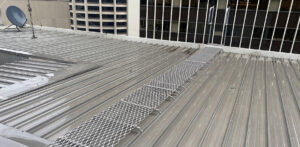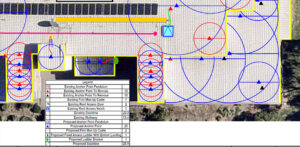The role of a facilities manager covers a broad range of areas, but keeping people working at heights safe is one aspect that is often not recognised.
Many workers would be completely unaware what the role of a facility manager is, and how that role influences what they do every day when attending their workplace. Facilities managers are responsible for the smooth running of office towers, factories, warehouses, residential apartments and more.
Generally, facility managers are responsible for looking after the maintenance and upkeep of a property. It may feel like only a commercial or industrial property would have a facility manager, but this is not always the case. If you live in an apartment complex or tower, it is highly possible your building may employ one.
The exact role can vary depending on the needs of each individual facility and the businesses that occupy them, but a good manager works at both an operational and strategic level. Day-to-day tasks can include ensuring blown lightbulbs are replaced, that lawns and gardens are maintained and broken windows get fixed. On a more strategic level a facility manager can assist building owners with planning building refurbishments or redevelopment, managing contracts for provision of other building-related services and running planned preventative maintenance (PPM) programs to ensure critical building functions, such as air-conditioning and security systems, operate without interruption or unexpected down time.
One aspect of that maintenance that many facilities managers are often unaware of is that many of these activities need to take place at heights and on the roof of their building. Many plant items, including HVAC systems, elevator plant rooms, solar panels and more are typically located there. Alongside this, there are other places where a fall is likely to occur such voids and elevator shafts.
As soon as a maintenance technician finds themselves having to gain roof access or enter a place where there is a risk of a fall in order to perform their work, they are entering a working at heights situation. Any person working at heights must be protected against the risk of a fall through the use of a fall protection or height safety system, alongside other measures including risk assessment, safe worth method statements (SWMS) and training.
Is a facility manager responsible for the safety of those working at heights?
In short, it depends.
Under workplace health and safety regulations, responsibility for a worker’s safety when they are performing tasks at height or on roofs falls with the “person conducting a business or undertaking” (PCBU). When it comes to working on site, the PCBU could be more than one person depending on the work being undertaken and the location where it is being undertaken.
For a facility manager, their responsibility is mainly to do with providing safe roof access and fall protection for those working in areas where there is risk of a fall. In most buildings, this takes the form of a permanent roof access system
What is a roof access system?
Roof access systems – which can also be called height safety systems or fall protection systems – take on many forms. Every building has different potential fall hazards and, as a result, the solution to providing safe access and fall protection must be tailored to meeting these unique requirements.
In some cases, the roof may have a guard rail or parapet (minimum 900mm in height) surrounding the perimeter of the roof. In this scenario, the guardrail or parapet could meet the perimeter fall protection requirements, and thus form your entire compliant system.
Falls off the edge are not the only risk when working at heights. Careful consideration should be given to other areas where there is a risk of a fall, for example through skylights or fragile roofing materials, or into voids within the roof area.
Other buildings may have other components making up their fall protection and roof access systems. Simpler systems may include a ladder bracket and anchor point providing access to a part of a roof. Other systems may have more sophisticated systems comprising multiple forms of fall protection covering a broader area of your roof.
How do I keep my roof access safe?
What a facility manager needs to do in order to ensure their roof access is as safe as can be reasonably practicable depends on whether a permanent system is installed on the roof, what components make up that system, its intended function and whether or not the installed system is compliant with all relevant legislation, standards and regulations.
For managers that know a system is not present on their roof, are unsure or need to clarify the potential restrictions or limitations of any installed system, a height safety audit is a good starting point.
A height safety audit provides facility managers with an overall picture of their height safety risks. Our experts inspect your roof and roof access.
Audit inspections include a thorough report detailing any deficiencies in an existing system, or provide an outline of what system should be installed in the absence of existing fall protection measures.
In circumstances where a fall protection or height safety system is known to be installed a simple recertification inspection may be all that is required.
Recertification inspections ensure that any installed height safety components are in good condition and have been installed in a manner that is compliant with the range of laws, regulations and standards that govern working at heights and workplace safety. These recertification inspections are required to be performed at least annually for permanently installed systems that are in use.
What if there are solar panels on my roof?
Having solar panels on a roof is even more of a reason to have a fully compliant fall protection system in place.
Solar panels, like any other plant, require regular cleaning and maintenance in order to continue operating in a safe and efficient manner. Having a compliant fall protection system on your roof makes performing that maintenance easy and safe.
Our facility is getting solar panels installed. What do I need to know?
Having solar panels installed on your roof is becoming increasingly common in both commercial and residential buildings.
When getting solar panels installed, care needs to be taken to make sure that installation does not compromise an existing roof access, height safety or fall protection system. As the location of existing permanent systems – such as anchor points and static lines – are often not considered when the design is completed. When the solar panel installation is performed, they can often be inadvertently removed, modified or covered up when the panels are placed on the roof. Should this occur, the roof access system can fall out of compliance and place safety at risk.
A review of your solar panel plans can ensure that a compliant height safety or fall protection system does not become rendered non-compliant through the installation process. A post-installation recertification or audit inspection can also determine whether or not your fall protection system is still compliant, or if rectification work may be required for it to function appropriately alongside your solar panels.
How do I find out more about height safety and roof access?
Height Safety Engineers have over 20 years’ experience providing facility managers with advice and services for their height safety, roof access and fall protection needs.
Our experts can answer any questions you may have and provide industry-leading advice that is comprehensive and easy to understand. Call our team today on 1300 884 978 or email enquiries@heightsafety.net here and make sure the people accessing and working on your roof are provided full compliant fall protection.





